Does your business need more personality? A unique vibe? It’s time to think about your brand voice.
Brand voice is an essential part of your full identity. Crafting a memorable one makes you and your product stand out and keep people coming back.
Cards Against Humanity‘s odd humor is a great example to start with. If you subscribe to their newsletters, you’re familiar with the email from “your father” encouraging you to buy “him” the all-new Dad Pack expansion.
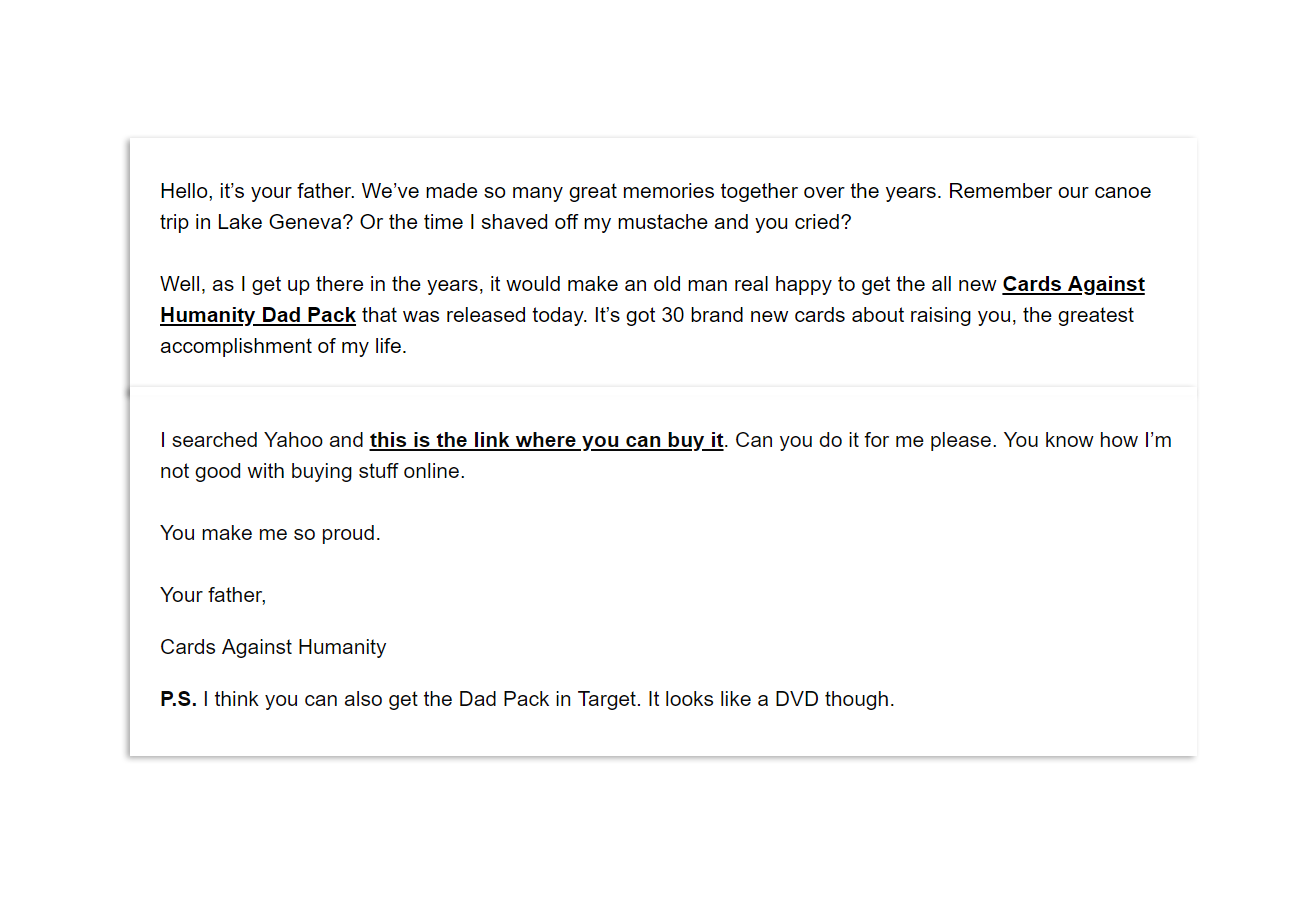
From Cards Against Humanity Newsletter
“Hello, it’s your father. We’ve made so many great memories together over the years. Remember our canoe trip in Lake Geneva? Or the time I shaved off my mustache and you cried?
Well, as I get up there in years, it would make an old man real happy to get the all new Cards Against Humanity Dad Pack that was released today. It’s got 30 brand new cards about raising you, the greatest accomplishment of my life.
I searched Yahoo and this is the link where you can buy it. Can you do it for me please. You know how I’m not good with buying stuff online.
You make me so proud.
Your father,
Cards Against Humanity
P.S. I think you can also get the Dad Pack in Target. It looks like a DVD though.”
Read this a few times if you have to. Cards Against Humanity remains consistent in their brand voice throughout this piece and the rest of their marketing materials.
The concept itself is spot on. There’s a lot of tongue-in-cheek humor with this company, and they’re talking to you as if they’re your own father. This humorous, yet ambiguous entity is your daddy.
Don’t even get us started on the Bigger, Blacker, Box expansion…
Looking beyond the humor, this company bursts with personality and charisma. All they’ve done is given themselves a little bit of character.
What is a Brand Voice?
Let’s start with the basics, shall we? A brand voice is a business’s personality and should be applied to all communication and marketing materials.
Are you friendly? Formal? Maybe even downright dirty. Cards Against Humanity loves the latter, and it works for them.
In today’s digital world, you have to be able to stand out. When all you’ve got is a screen to sell yourself, businesses have to be unique, personable, and engaging.
A good brand voice transforms average text into meaningful copy that tells a story.
That’s what you want to do; tell your brand story.
Wouldn’t you feel more comfortable doing business with a company you’ve connected with? That’s the way consumers feel as well.
Have a look at one of the most recognizable brands on the planet: Coca-Cola. Their tone and voice relies heavily on the feeling of happiness. In fact, they had the long-running campaign “Open Happiness” since 2009 all the way up until this past year.

“Open Happiness” Campaign Ad, Coca-Cola
It spawned other campaigns as well such as “Share a Coke”. The named Coke bottles were hard to miss. Their idea was to share with a friend or family member, smile, and be happy.
Do you see where this is going? It’s a fun process fleshing out your brand’s character.
Now that you have a better understanding of what a brand voice is, why it’s important, and how it works, it’s time to make one for yourself.
It may feel a bit daunting for some, but never fear – we’ve broken down a step-by-step process to help.
Step 1: Analyze the Current Status of Your Brand
Before we jump into creating a brand voice, some housekeeping is in order. You need to figure out where your business is now and how people perceive it.
Explore social media with relevant hashtags and Google your business. What comes up?
Use helpful tools like Google Trends. With it, you can see the world’s interest in you over time.
Do you see a sudden spike? Check the date and investigate why there was such a peak in interest.
What region is your business most popular in? And what are the related topics and queries?
Understanding this information will help you develop your brand voice.
That being said, don’t rely too much on trends. A solid voice is evergreen.
Get a feel for what’s happening with your brand. Taking the time to do so will not only help you create a fresh brand voice, it may highlight some problem areas that you need to address.
Step 2: Get Back to Your Roots
Now that you’ve seen how the world views you, take a moment to revisit your mission statement. Think about what your business means to you and what you want it to mean to your customers.
Ask yourself the following questions:
- What are people saying about us?
- How do people react to us?
- Do we have overwhelmingly negative or positive reviews?
- Does our online presence reflect our mission and values?
- Are consumers not perceiving us as we anticipated?
Your personality should reflect your values and who you are as a company. Identifying your original mission is the best starting point in determining what your brand voice should be.
In fact, maybe it’s time for a full rewrite. There’s nothing wrong with a revision to your mission statement. Give your business the space it needs to grow and evolve.
Let’s take a look at another famous example here: Microsoft. Their mission is “to empower every person and every organization on the planet to achieve more”.
It’s not a typical statement from a big tech company. If you think about it, this isn’t what comes to mind when you think of businesses in this industry.
When we think of computers, we think of working or even tasks that must be completed. Microsoft, however, thinks of empowerment, limitless possibilities, and planet-wide aspirations.
Their mission statement alone shows that Microsoft wants to do more and be more for their consumers. They strive to innovate and diversify their corporate landscape.

Mission statement, Microsoft website
Just look at the hero image on their About page. It’s an incredible view of the night sky just after sunset. The Milky Way hangs high over a tent. It evokes the idea of a small child dreaming of a better tomorrow.
See? Brand voice can extend far beyond the words on a page. It can be a powerful feeling that resonates with people, connecting them even more with your business.
Step 3: Research Your Audience
How can you know how to talk to your audience if you don’t know who you’re talking to?
Short answer: you can’t.
It’s like trying to speak to someone who doesn’t understand your language. Chances are that it won’t end well.
Understanding your audience is easier than you might think. For example, if you sell athletic gear, what do you think your audience is interested in? It could be sports, hiking, hunting, or something similar.
When you have a general idea of who you’re marketing to, it’s time to get inside the minds of your customers and create some buyer personas.
These personas are like profiles that depict your target customer. They should describe things like who the customer is, what their days are like, what challenges they face, and how they make decisions.
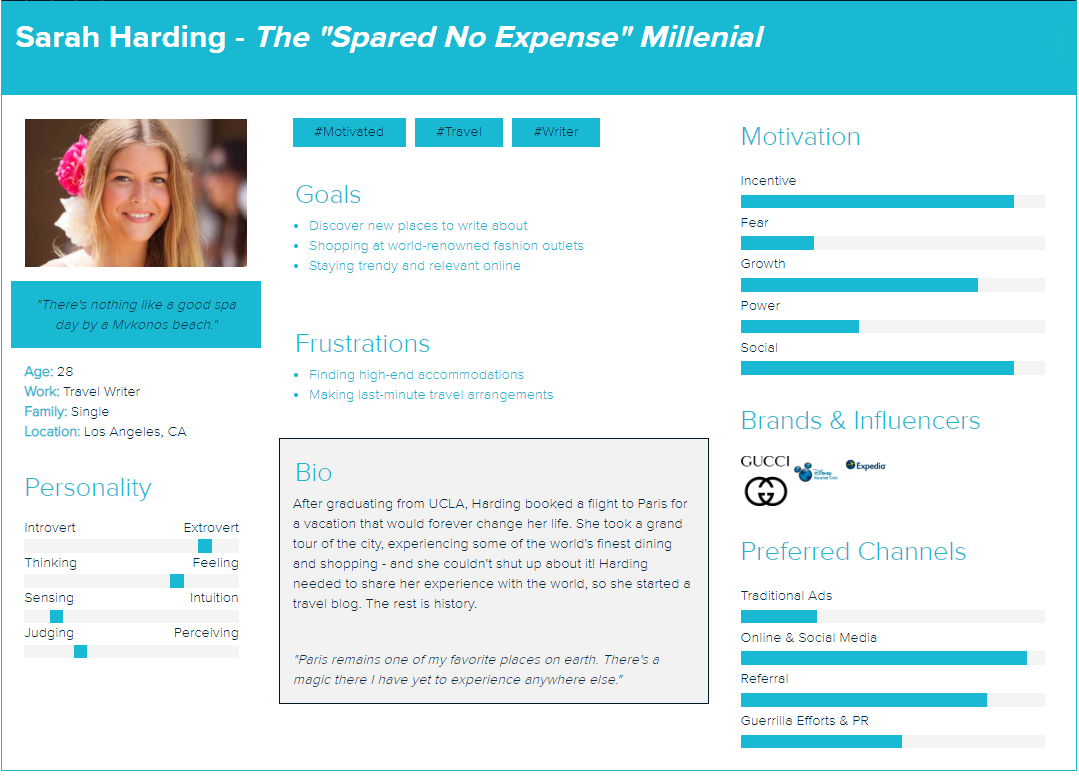
Buyer Persona made with Xtensio
The above image is a general example of how your buyer persona profile should look.
Your profiles should answer questions relevant to your audience and to your industry.
When it comes to branding and creating the proper voice, some businesses may have a wider variety of customer profiles depending on the reasons and ways different people use their product or service.
Their advertising can target those personas based on their unique goals and pain points, but their brand voice as a whole should cater to what all of those different customer profiles have in common.
If there is no common ground to unite the customer profiles, they may want to consider creating separate brands from their existing product or service variants to better cater to the needs of their different customer bases.
Understanding other information such as their preferred method of communication or favorite places to shop can help you determine where your brand voice would have the greatest impact.
Make more than one profile, and keep it close. Your personas can be invaluable in other areas of your business.
Step 4: Audit Your Messaging
If you’re a little late to the brand voice game and you’ve already got content and marketing out in the world, it’s time for an audit.
Review your assets. Your website is a great place to start. It’s the home of your brand voice and your blog if you’ve got one.
What is the first thing you see on your homepage? Consider it well, because this may be the first (and last) impression you make on a potential customer.
Does it match your mission statement? Is it a powerful image that exudes your brand voice?
If not, maybe it’s time to go back to the drawing board.
Don’t forget – that same tone should be carried out through every piece of copy, including your blog. Take the time to read through everything and look for areas to improve.
Do you post YouTube videos? This platform can be a powerful tool, so make sure you’re using it well.
Does every video you post convey the brand in a manner you want? Don’t just look at the content; you should consider the editing, the tone of the narrator (if there is one), and how much of a presence your brand has.
Viewers should not be underestimated, especially the YouTube community. They’ll know if you’re overselling yourself, and they won’t put up with it.
What about branded imagery? Think back to the Microsoft image. Your images may not have to be that awe-inspiring, but they should make your consumers feel something. That feeling should align with your mission.
Step 5: Create a Chart
Visuals go a long way in helping you and your employees understand this concept.
Go back to Step 1 and review your mission statement. Take a deep dive into what your company stands for.
Come up with 3-4 characteristics that describe your brand voice. Explain why you chose each characteristic as well as the do’s and don’t’s of using it.
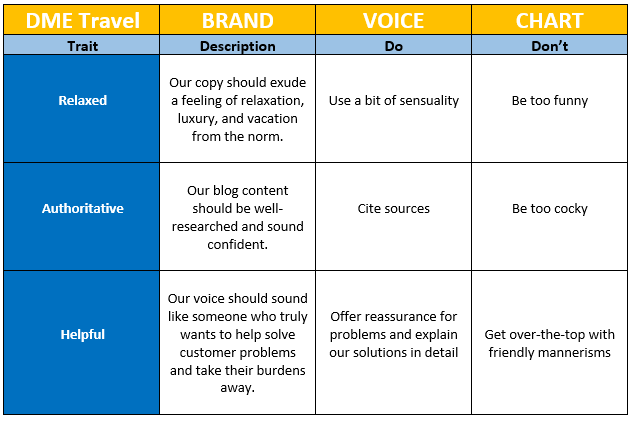
Don’t be afraid to get detailed with this. The more information you have outlined, the less likely a team member will portray the wrong or faulty brand voice.
It can also help you – as the business owner – keep track of the details as well when you’re creating content. At the very least, it’s good to have as reference.
Step 6: Enforce Consistency and Create Guidelines
Many businesses today maintain blogs to provide regular content to their visitors. This is a great opportunity to speak directly to customers, but it requires careful control over the voice you use to communicate.
Don’t leave your brand voice and identity to fate; give your team some clear guidelines.
Having a set of rules will ensure that voice is maintained throughout all public content. Everything a customer receives from you should sound like it comes from a single, consistent brand.
The chart you created in the previous step can be very helpful here. However, this is your chance to go even further into detail if you wish.
Maybe your brand voice has a particular focus on YouTube? Or you’re more particular about direct customer correspondence in emails. This is your chance to flesh out your voice as much as possible.
Yeah – it can be a lot to throw at your team. Host a workshop and break down your brand voice into its basic elements listed within your chart.
The more educated your people are, the stronger your brand voice will be across all mediums.
Tell the World Who You Are
Without a proper brand voice that’s clear and communicated well across all materials, your business will appear untrustworthy and unprofessional. Think about it – would you want to do business with someone who sounds different on every web page?
Or if tone switches between various Facebook ads?
Your business will find itself being a hard sell.
Follow these steps closely and you should be well on your way to creating a solid brand voice for all of your assets. It’s not just a fun and creative process, you’ll appear and feel more professional as a business owner.
Thinking about a new logo to accompany your new voice? Explore our guide on logo decisions that could make or break your brand.
For useful information and other resources, read through with the DME Digital Blog. You never know what you might find.
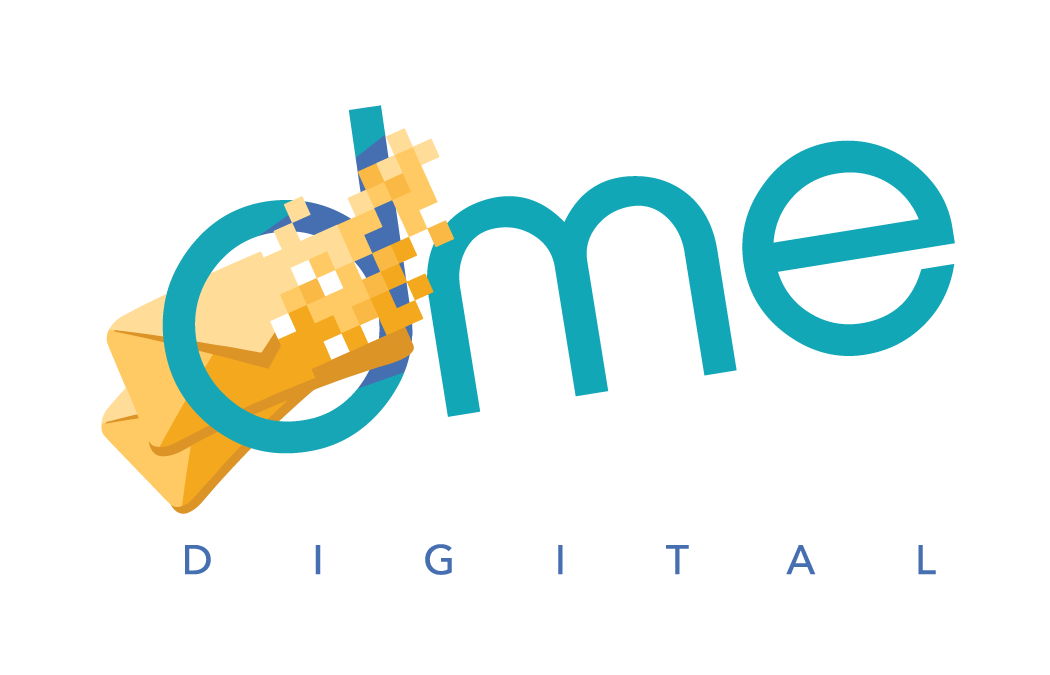
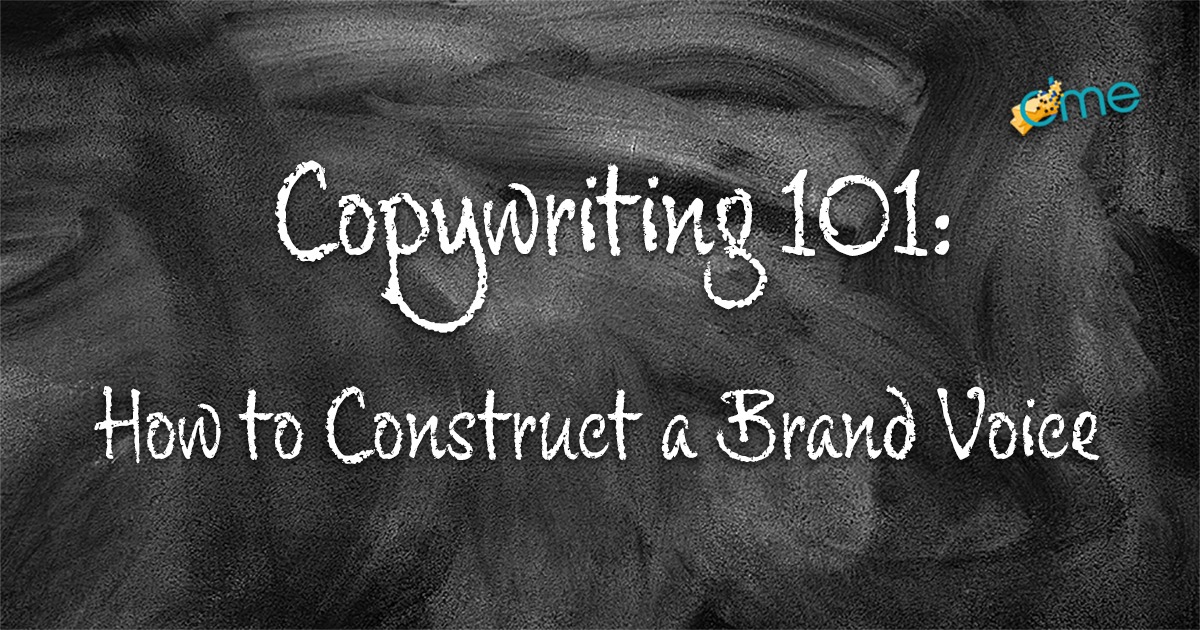










Leave a Reply